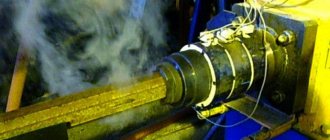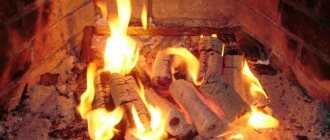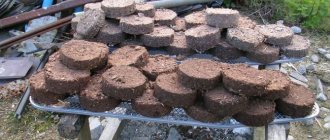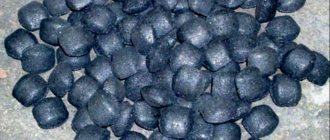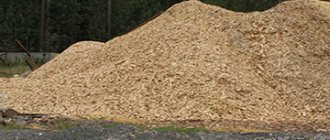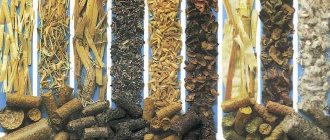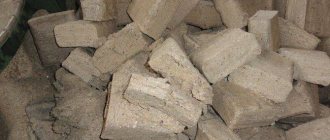It cannot be denied that sawdust briquettes are one of the most efficient types of solid fuel used for heating a home. They are high in calories (heat output is about 5 kW per 1 kg when burned), have a low ash content, and are also easy to store because they take up little space. But this fuel certainly cannot be called cheap; not everyone can afford to heat a boiler or stove with European wood throughout the entire season.
This is where many homeowners become interested - is it possible to somehow make fuel briquettes with your own hands? Especially when there are raw materials for this at a meager price. The solution to this issue is precisely the topic of this article. It will examine various technologies for producing briquettes from sawdust and other types of raw materials in production and at home. As a result, it will become clear under what circumstances it makes sense to take on this matter.
Features of the production of fuel briquettes
Fuel is made from the following types of raw materials:
- sawdust, wood chips, shavings, bark;
- cake, sunflower husks, husks of other seeds, incl. croup;
- peat;
- coal dust.
Briquettes made from wood waste are the most common.
Physics of the process
A portion of crushed raw materials is loaded into a mold and compressed with a press with a force of up to 3000 kg/sq.cm.
The output is a block with a higher density than wood: 1.08–1.40 g/cc versus 0.75–0.85. This fuel burns longer and does not produce sparks.
Application of adhesive
A binder is required to adhere fine particles to each other. Industrial production uses lignin contained in the raw materials themselves. It is a complex biopolymer synthesized by plants. Under the influence of high pressure and the resulting heating, the binder comes out of the cells and impregnates the briquette.
An adhesive is required to hold the particles together.
Thus, factory-made fuel does not contain chemical additives and is therefore environmentally friendly.
Most homemade presses are not capable of developing pressure sufficient to destroy plant cells and squeeze out lignin. Therefore, in home production, third-party binders are used:
- Clay solution. Add in an amount of 5–10% of the total weight of the mixture.
- Corrugated cardboard and other paper (contains lignin). The material is pre-soaked.
- Wallpaper glue. The cheapest one will do.
The proportion of glue and paper is selected experimentally - it depends on the humidity of the raw material and the pressure developed by the press.
The higher the lignin concentration in the wood, the lower the force required to squeeze it out. Data on the most common breeds are given in the table:
| Tree name | Mass fraction of lignin, % |
| Birch | 19 |
| Aspen | 22 |
| Spruce | 27 |
| Pine | 27 |
| Fir | 30 |
If a homemade press develops a lot of pressure, you should first try to make briquettes from softwood sawdust. It is possible that a third-party binder will not be needed.
Requirements for raw materials used
A properly prepared starting mass has the following parameters:
- Humidity – 4–10%. Excessive amounts of water impair combustion.
- Fraction or chip thickness – 2 mm. Large chips are pre-crushed in crushers.
- Lack of grass, sand, leaves, soil; bark content – no more than 5% by weight of the mixture. Such components disrupt the monolithic structure of the bar and make it crumbly.
At enterprises, the moisture content of raw materials is adjusted to the required value in heated dryers. In home production, it is kept in the sun and draft.
When using a third-party binder, sawdust is soaked in it, and the finished product is dried.
Equipment for the production of
The simplest press for making fuel briquettes, made by yourself, has a manual screw drive.
A molding container with perforations is filled with the mixture and placed under the bed; pressure is created by tightening the screw. The design is very simple and there is no point in talking about it in detail, just look at the drawing. Such screw machines for pressing briquettes from sawdust are not very popular due to their low productivity. It takes too much time to load the container, tighten the screw and remove the finished product. It is much faster and easier to squeeze out “bricks” using a homemade press with a long lever and a mechanism for pushing the briquettes out. To speed up the process, you can weld 2 molds to the frame instead of one.
Manual machine for 2 molds with a pipe lever
Some craftsmen can boast of more advanced mechanized equipment. Indeed, a manual machine can be improved and briquette productivity can be increased by installing a hydraulic jack instead of a manual drive. To assemble such a unit, you will have to tinker a lot, but the result will be much better.
Manual machine with hydraulic jack
Note. Even using a hydraulic jack in a homemade press, it will still not be possible to create a pressure of at least 300 bar. Therefore, it will still not be possible to reproduce the factory technology without adding water and binders.
Despite great difficulties in manufacturing the parts, some of the craftsmen managed to assemble a screw press and obtain briquettes of fairly decent quality. This is evidenced by the reviews of such people on the forums. But they all note the high costs of producing screw parts and housings from high quality steel. Again, you can’t do without an electric drive; at the most conservative estimate, a motor with a power of at least 7 kW is required.
General information about briquetting press
The equipment is produced in a variety of designs. The developed force varies from 500 to 3000 kgf/sq.cm.
Approximate cost in rubles:
- mini presses – 70,000–100,000;
- budget class models – 200,000;
- multifunctional machines with a long service life - from 300,000 to 1,000,000.
A homemade unit can be made at home from scrap materials.
Purpose
The press compresses fine-grained raw materials until they turn into a dense briquette. Expensive models simultaneously heat the source material to a temperature of +150...300°C, which promotes the release of lignin from plant cells.
The press compresses the raw materials into a dense briquette.
Machines designed for the continuous production of Euro firewood cut them into individual bars.
Design features: main elements
The main components of the press:
- Mixer. Mixes several types of raw materials until a homogeneous mixture is achieved.
- Matrix. Gives raw materials the desired shape.
- Punch. Applies pressure on the original mass.
- Operating mechanism with drive. Converts electrical energy into compression force.
- Bed. The base to which all components are attached.
Some models are additionally equipped with a heater and a knife.
Principle of operation
The mixture enters the matrix, where it is subjected to pressure from the punch. The raw material is compacted with simultaneous molding.
Operating principle of a briquette press.
According to the principle of operation, machines are divided into 2 types:
- Intermittent. During production, the cycle is repeated many times: loading of raw materials – compression – removal of the finished product from the mold.
- Continuous (extruders). Adding raw materials and squeezing out the product occurs constantly, while at the same time the latter is cut into bars.
Production
The production of pellets cannot be called a complex process, but it requires high-quality equipment.
If in the production of wood concrete an important element of production was a chip cutter, then in the case of the production of wood pellets it is only one of a number of necessary ones, but not the most expensive.
The heart of production is the granulator press .
It is he who produces the final product - pressed wood pellets .
It is often possible to simplify production by substituting technological cycles. However, in the production of pellets, simplification is only permissible in the design of the press, which is directly related to the productivity of the installation.
The granulator, which is used in the production of feed from meat and bone meal, and the granulator, which is used in the production of pellets, are very similar in appearance.
Despite the similarities, a feed granulator will not be able to produce pellets with a density normal for fuel pellets due to:
- features of the materials used;
- calculated loads.
Why this happens - we will consider in detail below.
Technology
The production technology of pellets, like most types of briquettes, is based on lignin .
This substance is released during the direct production of pellets (briquettes).
In order for the pellets to be obtained in accordance with the required parameters, several rules must be followed, thanks to which the desired product is obtained.
At the entrance we do not always have either pure sawdust or sawdust cuttings.
Branches from plots in the forest can also be used as raw materials. But this is profitable when the production itself is nearby. The raw materials can be:
- sawdust,
- shavings from the workshop.
The essence of the technology is to give raw materials, regardless of their original appearance, the required dimensions and moisture content immediately before pressing.
Stages
Chip cutting
The very first stage, when wood waste is chopped into chips for subsequent drying.
The nuances lie in the dimensions of the raw materials.
If the production of pellets is powerful, with noticeable ratios in terms of the mass of products produced per hour, then the equipment can easily grind into chips without pre-treatment:
- stumps,
- trunks of fallen trees,
- other waste.
An ordinary PM-200 type chipper can process only branches and twigs that do not exceed the size of the neck of the loading opening.
Screw and rotary chippers for large-sized wood waste belong to a higher class of equipment; they allow processing several tons of wood per hour.
Drying
Drying wood chips is necessary for two reasons, and compliance with these standards is important for the correct completion of the technological process. Initial drying is achieved by laying the wood chips in piles, without forced drying on drying lines, although such an initial option is also possible.
The initial cutting into chips does not always give the result that is expected from a chipper. Before sending the resulting wood chips for regrinding, it must be dried, since the principle of operation of the grinder is based on the physical properties of dry wood chips , not raw wood.
The second important point is that for the release of lignin contained in wood cells and for gluing particles in the press, a certain humidity , and this humidity is also regulated from the point of view of the quality of the resulting product.
Regrinding
Adjusting the size of the chips to sizes acceptable for processing in a granulator is the next step after drying.
Additional grinding of woodchips is carried out in hammer mills .
As a result, the size of the raw material is reduced to values of no more than 4 mm in any dimension.
This standard size of raw material can also be obtained if you have a flake machine .
Raw materials enter it in the form of:
- wood chips
- roots,
- stumps,
- branches,
- trimmings from the sawmill.
It is precisely because of the size of the granulator matrix that compliance with the size of the raw material fraction is required.
Hydration
The quality of the product exiting the granulator is regulated by the moisture content of the raw materials. The average humidity of sawdust or crushed wood chips entering the granulator press should range from 7 to 10%, since this is the most optimal ratio of the moisture content of the raw material to its volume .
Humidity, as mentioned above, is better to bring it from the minimum value to the optimal value, rather than setting up drying lines for raw materials with sampling and moisture measurements.
In drum-type humidifiers, the raw materials passing through the drum hopper are processed with hot steam, which penetrates the mass of raw materials and condenses on the surface of the sawdust. This is the best option for hydration.
The ratio of water molecules in steam in terms of volume allows you to narrowly regulate the total volume of water for the entire passing mass of raw materials.
Production
A press granulator for the production of pellets has a so-called matrix .
It may be:
- flat metal surface
- round (cylindrical).
Flat die presses originally designed for use where high pressure was not required at the contact points:
- in feed granulators,
- for the chemical industry.
Presses with a round matrix were created from the very beginning for the production of pellets. After the start of using rollers and flat dies made of high-alloy metals and alloys, it became possible to use models of granulators with flat dies in the production of pellets.
The matrix in its structure is a metal part with a thickness of 3 cm, with holes from 6-10 mm, depending on the performance.
Rollers in the contact zone with the matrix create crushing of the raw material due to pressure and push the mass through holes in the matrix , at the exit from which knives cut off the emerging cylindrical granules.
The operating temperature in the contact zone can reach high temperatures , but the optimal temperature is considered to be 100-120 degrees Celsius.
It is at this temperature, when the fibers and cells of wood are crushed, that the lignin released under the influence of moisture in the raw material glues the wood pulp together. In this case, the compaction of wood in comparison with the incoming raw materials reaches three times the size.
It is strictly not recommended to exceed the established temperature and humidity thresholds. At excessively high temperatures and normal humidity, high-quality gluing of wood raw materials does not occur, and at increased humidity, the steam inside the pellets breaks the pellets themselves.
These reasons can negate the entire granulation process with a high percentage of defects.
Therefore, many models of granulators also have a built-in pellet cooler. If all requirements for temperature and other conditions are met, the output is granules of very high quality . We will look at examples of equipment below.
Equipment
Equipment for the production of wood pellets is produced by many enterprises. Let us briefly consider the main models of machines for the production of sawdust pellets.
Domestic manufacturers
- Pellet press MZLP-200, Moscow.
- productivity up to 100 kg per hour,
- engine power 5.5 kW/h,
- granule diameter 6 mm,
- price 150 thousand rubles.
- Chip cutter MP-5, Izhevsk.
- productivity 5 m3/hour,
- engine power 40 kW/hour,
- cost from 190 thousand rubles.
- Hammer chopper MI-3, Izhevsk.
- productivity 1 ton per hour,
- engine power 40 kW/hour.
- costs from 360 thousand rubles.
- Aerodynamic drying, LLC “Kupets”, Perm.
- total power 7 kW/hour,
- productivity up to 400 kg/hour,
- price 15.6 thousand USD.
Foreign manufacturers
- Dryer drum for pellet raw materials, Germany-China, supplier "AsiaTechnoImport", Novosibirsk.
- total power 15 kW/hour.
- dimensions 1.5 x 12 m.
- Press granulator CPM (California Pellet Mill), USA/Netherlands.
- productivity up to 5000 kg per hour,
- engine power from 90 to 500 kW/hour,
- diameter of granules depending on model,
- price from 160 thousand euros.
- SKJ2 series pellet granulator, Germany-China.
- engine power 3 kW,
- productivity up to 50 kg/hour,
- cost 80 thousand rubles.
- Cooling hopper for pellets SKLN, Germany-China.
- engine power 60 kW/hour,
- productivity up to 1500 kg/hour.
The process of making pellets in production is presented in the video:
Species diversity
There are several types of presses:
- hydraulic;
- screw;
- shock-mechanical;
- granulators.
The differences lie in the method of creating pressure and the characteristics of the briquettes.
Hydraulic
Machines of this type have the following characteristics:
- The production method is intermittent.
- The working mechanism is hydraulic: force is created by pumping oil into the cavity of the hydraulic cylinder.
- Specific pressure – 500–1500 kg/sq.cm.
The hydraulic machine has an intermittent production method.
Raw materials are loaded in portions into a mold (glass). After compression, the finished briquette is removed.
Hydraulic presses have 2 advantages:
- low cost;
- briquettes are shaped like bricks (RUF), which makes transportation and storage easier.
Flaws:
- low productivity;
- relatively low pressure - the density of the bars does not exceed 0.75–0.8 kg/cc.
Screw
Press characteristics:
- The manufacturing method is continuous.
- The working body is a rotating auger (like in a kitchen meat grinder).
- Specific pressure – up to 3000 kg/sq.cm.
The press operates on the principle of extrusion: a screw forces the mixture through a gradually narrowing hole - a die. Due to the conical shape of the channel, the compression force from its walls is several times higher than the pressure developed by the screw. A similar effect is observed when driving a wedge into a crack, which leads to the splitting of a tree trunk.
A screw press forces the mixture through a tapering hole.
Installation benefits:
- High density of briquettes – 1.08–1.40 kg/cc. This fuel burns for a long time and produces a lot of heat.
- High performance. Thanks to the continuous operation of the extruder, it is possible to produce more briquettes per unit of time than with a hydraulic installation.
- The log has a Pini&Kay format - with a hexagonal cross-section and a through hole in the middle. The channel ensures the flow of air to the internal layers and, as a result, the most complete combustion and minimum ash content.
The disadvantage of a screw press is its high cost.
Impact-mechanical
Equipment characteristics:
- The production method is continuous.
- The working body is a rotating crankshaft with a connecting rod attached to it (crank mechanism).
- Specific pressure – up to 2500 kg/sq.cm.
There is another type of extruder, when the raw material is forced through a die by a piston moving back and forth.
In terms of cost and productivity, mechanical impact presses occupy a middle position between hydraulic and screw models. The same can be said about the density of the bar: it is 1–1.15 kg/cc. It has a round cross-section (Nestro type) with a through hole.
The mechanical impact press operates continuously.
The disadvantage of the equipment is accelerated wear of the bearing due to impact.
Despite this, such presses have become widespread due to the optimal combination of installation price and product quality.
Press granulator
This is a universal extruder for the production of fine-grained pressed products. If the raw material is crushed grain, the output is compound feed; if sawdust, peat, seed husks, etc. - fuel granules (pellets). The advantage of small-caliber briquettes is the possibility of automatically feeding them into the combustion chamber of the boiler using a screw or piston feeder. The heat generator must be equipped with a special pellet burner.
Why are briquettes good?
Fuel briquettes are crushed wood and wood waste, compressed into a form convenient for transportation and storage.
As a result of processing on machines by pressing under high pressure, the finished briquettes acquire new qualities. Their use instead of conventional firewood in stoves, fireplaces and wood-burning boilers provides the following advantages:
- increased combustion temperature and, accordingly, better heat transfer;
- a higher density of briquettes leads to longer burning of the same volume;
- reduced formation of soot and ash residues;
- Briquettes are produced in various shapes - short cylinders, rectangular bricks. But in any case, they are convenient for storage and carrying.
When compared with conventional firewood, Euro-firewood will not be worse in any respect. The disadvantages include the fact that by the appearance of the briquette it is not always possible to determine the specific wood from which it is made. And if, for example, birch briquettes are required, then you have to rely on the integrity of the manufacturer.
Press selection criteria: what to look for
When choosing a machine, consider the following:
- Electric motor power. It is limited by the capacity of the circuit breaker at the entrance to the house and the cross-section of the cables. The most energy-intensive are screw units.
- Distance to the supplier's service department. The closer it is located, the faster the repairs will be completed and the less losses there will be from equipment downtime.
- Telephone consultation. A useful service from a supplier or dealer can help you avoid mistakes and save money.
- Volume of available raw materials and market capacity. The costs of purchasing a machine with excessive productivity will be unreasonably high, and along with them the cost of repairs. These factors will increase the payback period of the equipment and lead to a decrease in production profits.
When choosing a machine, consider the power of the electric motor.
Equipment for creating heating material
Today, there are many companies that supply equipment for the production of fuel briquettes, and often they also offer installation services. In some cases, lessons are provided on how to use the devices.
To make your own fuel you will need the following:
- for grinding recyclable materials;
- Briquetting press (hydraulic, screw or impact-mechanical;
- finished product.
If it is possible to dry the material in the fresh air or receive it dry from other industries, then you can do without a drying complex, but it should be taken into account that the sawdust should have a moisture content of no more than 13%. And when using sawdust, you don’t need a crusher.
Methods for creating a device
It is impossible to make an extruder at home. All homemade machines press briquettes into a mold (glass) in an intermittent manner.
The main task of the designer is to ensure a specific pressure of at least 150 kg/sq.cm. This value is determined by 2 factors:
- force generated by the press (direct relationship);
- cross-sectional area of the mold (reverse).
By selecting the ratio of these parameters, the desired characteristics are achieved.
For example, a machine presses on a portion of raw materials with a force of 1350 kgf. If the block has a cross-section of 5x5 cm, the specific pressure will be:
P = 1350 / (5 x 5) = 54 kgf/sq.cm
At such low rates, the briquette will crumble. By reducing the dimensions of its cross-section to 3x3 cm, the designer will increase the specific pressure to:
P1 = 1350 / (3 x 3) = 150 kgf/sq.cm
There are several ways to achieve high force.
The designer's task is to ensure the specific pressure of the press.
Use of muscular strength and leverage
This is the simplest version of the press; all its elements can be made at home.
A strong pipe is used as a lever, for example a reinforced water pipe with a diameter of 40–50 mm and a wall thickness of 4–4.5 (mm). One end of it is equipped with an axis and fixed in a bracket so that the other side can be raised and lowered.
A rod with a punch is attached at a short distance from the point of rotation.
The compression force will be equal to Q = P * (L / L1), where:
- P – operator’s weight acting on the free end of the lever;
- L – pipe length;
- L1 – distance from the point of rotation to the junction of the rod and the punch.
Example:
- operator weighs 90 kg;
- lever length – 3 m;
- the distance from the pipe rotation point to the punch is 0.3 m.
Under these conditions, the compression force will be:
Q = 90 * (3 / 0.3) = 900 kgf
It must be taken into account that the same force acts on the bracket at the point of rotation of the lever, so it must be strong.
To achieve a pressure of 150 kgf/sq.cm, the cross-sectional area of the bar must be equal to:
S = 900 / 150 = 6 sq.cm
The lever installation is designed so that briquetting is carried out in one step. Otherwise, you will have to waste time adding raw materials, which will lead to a decrease in productivity.
The immersion depth of the punch depends on the volume of the portion. It is calculated using the formula A = H * (1 – (p1 / p2)), where:
- H – height of the glass;
- p1 and p2 are the density of raw materials and briquettes, respectively.
The larger A, the further the rod needs to be moved from the point of rotation. But this leads to a decrease in compression force.
The parameters are selected as follows:
- Calculate the cross-sectional area of the pipe from which the glass will be made.
- The required force is calculated and based on this the distance of the rod to the point of rotation is determined.
- A test briquette is made.
- If in 1 approach it was not possible to achieve the required degree of compression, cut off part of the glass to reduce its length.
Formula for calculating the piston pressure force (m) depending on the force applied by a person (M), the distance from the piston to the lever attachment point (l) and its total length (L)
If high productivity is not needed, the briquette is made in several stages, adding more raw materials.
To increase the pressure on the lever, you can attract an assistant.
Application of hydraulic jack
A household hydraulic jack develops a force of 30–40 tf. If you equip a press with it, the available mold area will be:
S = 30000 / 150 = 200 sq.cm
The hydraulic jack develops a lot of force.
This machine can be equipped with several forms. Then the frame for the punches is made of durable rolled products, for example an I-beam or a thick-walled profiled pipe.
The disadvantage of a press based on a hydraulic jack is the long cycle time. But it has higher productivity, and the briquettes are more similar to those made industrially.
The design of a typical hydraulic press consists of a frame and a movable beam on which a jack is placed. The system returns to its original position due to the action of springs
Screw pressing mechanism
Another device for enhancing muscle strength is a screw. The amount of pressure it creates is calculated based on the “golden rule of mechanics”.
L1 / L2 = Q2 / Q1, where:
- L1 – path traveled by the point of application of muscular force;
- L2 – movement of the punch mounted on a screw or lever;
- Q1 – muscular strength;
- Q2 – pressure developed by the press.
Example:
- the length of the handle in the screw shank is 80 cm (2 arms of 40 cm each);
- force applied by the operator – Q1=40 kgf;
- screw thread pitch – 3 mm.
The screw pressing mechanism enhances muscle strength.
For 1 revolution, the point of application of muscular force, i.e. the end of the handle will go the following way:
L1 = 2 * P * 40 = 2 * 3.14 * 40 = 251.2 cm
The punch will drop to L2 = 3 mm = 0.3 cm. The force of its influence on the raw material is equal to:
P2 = (L1 * P1) / L2 = (251.2 * 40) / 0.3 = 33493 kgf
The actual force will be less because The operator will spend part of the energy to overcome friction in the screw-nut pair. The average efficiency of such devices is 25–30%. This means that the press considered in this example presses on a portion of raw materials with a force of 33493.3 * 0.25 = 8373.3 kgf.
Advantages of screw presses:
- the greatest strength among hand-held devices;
- compactness;
- simple design.
Flaws:
- the cycle is longer;
- The manufacture of the screw and nut will have to be ordered by a turner.
The operator must control the applied force, otherwise the thread may be stripped.
It is recommended to increase the pressure little by little and, as soon as an acceptable result is obtained, put a mark on the screw indicating the extreme position.
Industrial production
The first step in producing fuel briquettes in an industrial environment is grinding the material on special machines. Often the raw materials for making briquettes are wood processing waste - shavings, sawdust, wood chips. Large pieces of wood are crushed to sawdust no larger than 4 mm.
Then the wood is thoroughly dried. The specific humidity of the material is brought to 10% or even less. The drier the wood for subsequent briquetting, the better the quality of the finished fuel.
The final stage is obtaining the fuel briquettes themselves. To do this, the prepared raw materials are subjected to powerful pressure. The temperature rises, and a sticky component, lignin, is released from the wood pulp. Under high pressure and in the presence of lignin binder, wood pulp is formed into a single solid briquette.
The density of such a product exceeds the density of natural wood by 1.5-2 times, which provides briquette fuel with increased heat transfer and increases combustion duration. In the industrial production of Euro-firewood, two methods of compression are distinguished.
Pressing method
In pressing, the raw materials are pressed into prepared molds using a hydraulic press. The typical pressure in a machine for pressing the production of fuel briquettes is 300-600 atmospheres. The output is briquettes in the form of rectangular bricks or short cylinders, depending on the shape in which they are pressed.
Extrusion method
With this method, wood pulp is constantly squeezed out of the outlet of the working channel. The raw material is loaded into a hopper, from there it is fed into the working channel, where it is additionally heated. The channel is made in the form of a cone, tapering towards the exit. The supply of raw materials from the hopper and its compression in the working channel is carried out on the machine using a screw screw. Such a screw-based press provides pressure on the raw material mass of up to 1000 atmospheres. The compressed “sausage” coming out of the extrusion unit is cooled and cut into rods of the required size.
Instructions for making a press
To create a homemade machine you will need the following tools:
- welding machine;
- grinder with cutting discs for metal;
- drill;
- roulette;
- pencil or marker.
To create a homemade machine, you need a welding machine.
The procedure depends on which drive will be used.
Manual
They start with making the frame. This part absorbs all the forces arising in the structural elements, so it must be strong. The bed is a frame made of a thick angle or profiled pipe with reinforcement in places subject to the greatest pressure.
At the next stage, a mold is made. To do this, a fragment of the required length is cut from a round or square pipe with thick walls. Several thin holes are made at the bottom of the glass to allow air and moisture to escape.
You need to think about a way to remove the finished briquette from the mold.
There are 3 options:
- The glass is equipped with a movable bottom with a spring underneath. It pushes out the briquette after the load is removed. The disadvantage of this solution is that the spring wears out quickly, losing its elasticity.
- They make a removable bottom. It is dismantled at the end of the cycle, then the finished briquette is pushed out by a press.
- Use a collapsible glass of 2 halves. Before pressing, 2 rings of reinforcement are put on it.
The mold is placed in a container or scalded around the perimeter so that the water that spills out of it during the pressing process does not spread.
A hand press begins with the manufacture of a bed.
The punch is cut from a steel sheet with a thickness of at least 3 mm.
Finally, a bracket is welded to the frame, after inserting the lever axis into it, or 4 stands with a nut for the screw mechanism.
Drawings of a press for making briquettes
With electric motor
The model based on a hydraulic jack with a pump and motor is subject to higher requirements in terms of strength. Proceed in this order:
- Make a welded frame from channels.
- Weld 1.5 m long posts in the corners.
- Between them, attach a drum for mixing sawdust and binder, removed from an old washing machine or made from a large diameter pipe.
- Below, install a galvanized steel tray to feed the mixture into the mold.
- Attach a hydraulic jack to the racks.
- Make and then install the glass and punch in place, as in the manual version.
The press is ready for use.
Briquette creation technology
The production of pellets and briquettes from wood waste by pressing is a long-established process. Therefore, when creating a homemade machine to obtain high-quality “European firewood”, you do not need to invent anything, but you can apply existing developments.
Description of the physics of the process
The use of bulk wood material for heating finds its application in small boiler rooms and furnaces. Sawdust provides the same energy as wood of similar mass and moisture content, but storing it in its natural state creates dirt and dust. Therefore, such waste is pressed into briquettes of various shapes.
With some assumptions, we can say that wood consists of fiber (cellulose) and its binding substance - lignin. Each piece of sawdust and shavings retains its integrity thanks to this polymer. In order to establish strong connections between the individual pieces, they also need to be glued together.
The chemical composition of wood and sawdust-pressed products is the same. But the physical structure of the briquette is different from the structure of a solid mass, which leads to its longer combustion
During the pressing process, strong pressure is applied to the sawdust, as a result of which lignin is released from it and holds the material together in the mold. This bond, of course, is not as strong as in solid wood, but it is enough so that the resulting briquette does not fall apart.
The amount of lignin in wood relative to dry mass depends on the tree species:
- fir: 30%;
- pine: 27%;
- spruce: 27%;
- aspen: 22%;
- birch: 19%.
The higher the percentage of lignin content, the less pressure is needed to release it. Therefore, it is easier to independently produce briquettes based on sawdust from fir than from birch.
In addition to the classic press for producing fuel from bulk materials, there is also an extrusion machine. The essence of its work is that, under the action of a screw, the substance passes through a gradually narrowing channel.
This creates very high pressure. However, implementing this option at home is complex and requires specific knowledge, so it is better to focus on models with a mold.
Use of adhesive
In the industrial production of pressed fuel, machines are used to create pressure in the range of 500 – 3000 atm. Some manufacturers (for example, German) form a briquette through a combination of compression with a force of 2000 atm. and heating the raw materials to a temperature of 150°C. The density of such products reaches 1.2 kg/dm3.
An industrial sawdust pressing machine is expensive and has high productivity. It is unprofitable for the production of briquettes in small quantities
If you make a briquette press from scrap material with your own hands, you will not be able to achieve such characteristics. Therefore, the products will definitely have a lower density and be more prone to crumbling.
You can compensate for the insufficient release of lignin and achieve greater strength of sawdust briquettes by adding a third-party adhesive, such as:
- Slurry. The required mass fraction of this binder dissolved in water is from 5 to 10% of the total weight.
- Wet corrugated cardboard.
- The cheapest wallpaper glue diluted in water.
The percentage of corrugated cardboard or glue is determined experimentally, since it depends on the size of the sawdust, its humidity and the pressure created in the mold.
Requirements for raw materials used
Even when using industrial equipment, it is difficult to obtain high-quality briquettes or pellets from wood waste if their thickness is more than 4 mm. The size of the material for homemade devices should be smaller. This is due to lower pressure and lack of heating of the raw material.
Ideally, the sawdust diameter and chip thickness should not be more than 2 mm. The vast majority of wood waste fits these parameters.
But there are times when the raw materials are clogged with small branches, wood chips or wane (pieces of bark). Then, before pressing, to obtain a homogeneous mass, it is necessary to carry out preliminary preparation - crush the material by passing it through a crusher.
You can make a crusher for producing wood waste up to 2 mm thick yourself. An ordinary garden shredder will not work, as it produces a large fraction size
To achieve good briquette density, you must avoid raw materials clogged with grass, sand or soil. The soil-vegetative layer, unlike clay, does not have astringent properties, so the pressed product will crumble easily.
You also need to comply with the percentage ratio of the amount of bark - it should not be more than 5%. It is impossible to measure this, but visually sawdust with a significant amount of wane appears darker. The sawdust must be dry. Increased humidity leads to greater briquette looseness and a decrease in its specific calorific value.
You can dry the raw materials in the summer either in the sun or in a ventilated area. In winter, drying should be carried out in a veranda or other utility room with a slightly positive temperature. For more intense evaporation, forced ventilation can be used.
The moisture content of sawdust or shavings should be measured according to the table above. Using a moisture meter will not give the correct result, since it can only determine the value on the surface of the heap
If the pressure in a homemade press for making briquettes from sawdust is insufficient to release lignin, then the raw materials are not dried, but rather soaked in water along with an additional fastening agent. In this case, better homogeneity is achieved during mixing, and excess moisture will be removed during compaction.
Useful tips and general recommendations
The creators of homemade briquetting machines advise doing this:
- Start designing with a detailed drawing indicating dimensions. This will avoid mistakes and accurately determine the amount of materials needed.
- Entrust the strength calculations of parts to a mechanical engineer or builder who is well versed in the strength of materials.
- Periodically check the product for bends and distortions and, if found, eliminate them. Otherwise, the quality of the briquettes will suffer.
- Dry the finished bars in the sun or in a ventilated area. This will ensure high calorific value of the fuel.
Using clay as a binder, make sure there is no soil in it. Otherwise, the briquettes will crumble.
More about briquetting technology
At the beginning of the last century, Russian researcher A.P. Veshnyakov proposed pressing the fine fraction into elements of a certain shape and size, which in terms of heat transfer were not inferior to the coal itself. The idea has found wide application both in everyday life and in industry.
Coal briquettes on a screening belt
Today, pressed coal is classified depending on the material, environmental friendliness, security, shape and type of packaging. But the two main types are:
- For production with the addition of binding components.
- For home use without additives.
It is important to know that industrial briquettes should absolutely not be used in everyday life. When they burn, a large amount of toxic substances are released, for which special equipment is responsible for removing them under production conditions. Previously, additives in the form of molasses or starch were used in the production of household briquettes. But this technology is a thing of the past.
How to make briquettes?
The technological process used in production cannot be carried out at home. The reason is the lack of pressing or extrusion equipment capable of creating a pressure of at least 30 MPa. Without this, lignin cannot be isolated from wood and homemade briquettes will not be compressed. The solution is simple: you need to add a binder, which is ordinary clay. It is mixed with sawdust in a ratio of 1:10 by weight (1 kg of clay per 10 kg of waste), diluted with water and mixed thoroughly.
The resulting composition is filled into the mold and the mechanism is activated. If the production of fuel briquettes is done manually, then it is necessary to apply maximum force and hold the lever until the water runs out. Then the product is carefully removed and placed on an area in the open sun to dry. You can start filling out the form again and extruding the next “brick”.
